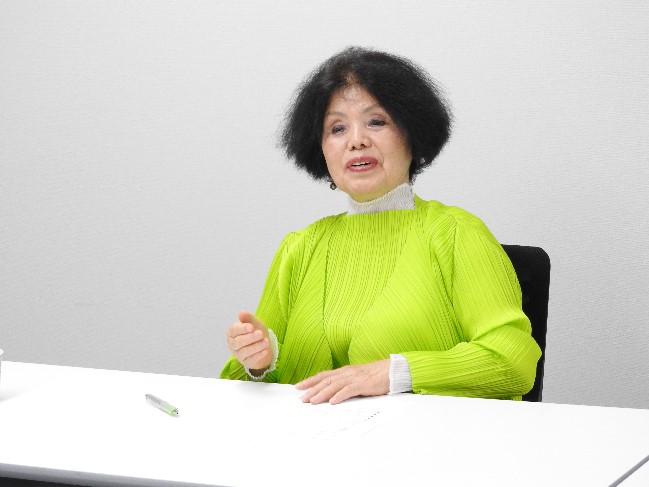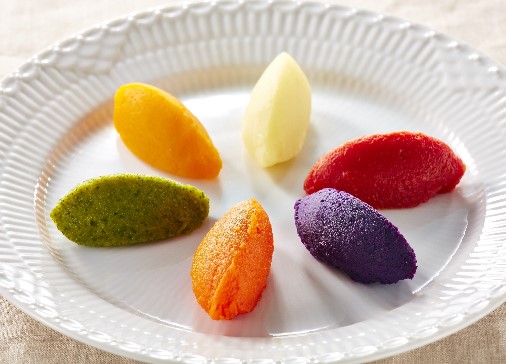News & Blogs
In this blog, we touch on diverse topics about Japanese food cultures, practices together with the culinary secret, TREHA®, and its important role in the Japanese food industry. We hope our blog helps you obtain in-depth knowledge of the secrets and science behind Japanese cuisine, shared from our kitchen, to yours.
This blog presents an interview held in 2019 with Ms. Setsuko Kanaya, the head of Kanaya Nutrition Research Institute in Japan. For the first half of the interview, she talked about importance of oral food intake and standards for the dysphagia diet. For the latter half, she will talk in more detail about her experience in developing the dysphagia diet, and what to be careful of when making an appropriate dysphagia diet. With decades of experience, she reflects on the progress of the dysphagia diet in recent years.
Needs of the dysphagia diet - is it safe and easy to swallow?
Team TREHA®: So how did you develop a way for patients to make a ‘food bolus’ while eating?
Ms. Kanaya: While making a food bolus, I thought I could gel the food ingredients. There were many gelling agents such as starch, agar and gelatin – I started to look into which one was the best. Seirei Mikatahara General Hospital had served carrot-based juice for patients 65 and older to compensate for nutrition from vegetables, so I tested each gelling agent in the juice to assess performance. Gel formed by agar tended to form tiny bits and pieces in the mouth, which made it difficult to swallow and could induce aspiration.
Team TREHA®: Do you have any other points to consider when cooking food for dysphagia patients?
Ms. Kanaya: You’d better to take conscious efforts to use oils and fats. Thinking about fish for dysphagia patients, salmon is better than sea bream. Salmon is easier to swallow compared to sea bream because salmon contains more fat than sea bream. I had examined a correlation between fat content and difficulty of swallowing using minced tuna, and found 10% is the threshold for making it suitable for dysphagia patients. Another food high in fat is foie gras, it has 45% fat content and is perfect as a dysphagia food.
It’s even better if you consider function of oil and fat in the body. MCT oil (medium chain fatty acid) might stabilize Alzheimer's disease, n-3 oils such as perilla oil might reduce inflammation. You may make the dysphagia diet healthier and easier to eat using these oils. Furthermore, fats and oils may improve defecation of patients. We may be happy until the end of our lives if we can eat and eliminate by ourselves. I believe that the dysphagia diet should be designed to consider elimination.
Team TREHA®: How about safety, such as avoiding aspiration and suffocation?
Ms. Kanaya: Dysphagia patients tend to have “pharyngeal residue” after a meal. Pharyngeal residue may cause aspiration or suffocation when patients lay down, entering the airways or clogging the throat. Alternate swallowing is the recommended way to eat a meal using the dysphagia diet, for example, using a green tea jelly made of gelatin. The patient swallows food, such as porridge, then green tea jelly, then food again. Gelatin has physical properties that gathers food residue in the pharynges, preventing pharyngeal residue by removing it each time.

Giving patients the pleasure of eating - the taste of memories and sophisticated dishes.
Team TREHA®: What do you need to be mindful of when cooking a dysphagia diet?
Ms.Kanaya: Patients taught me everything about developing a dysphagia diet. I tried to catch the messages patients gave me - what they could eat, what they liked and disliked eating, and then tried to incorporate as much as I could. I’d like to share a story of my patient who loved sashimi (raw fish fillet) but had serious dysphagia. Although everyone thought he could not eat sashimi any more, I served finely minced raw tuna with wasabi. Imagine how delighted he was, and what a surprise to him that he could swallow minced tuna without any trouble. I assumed his salivary flow had increased because he really loved sashimi, and that helped him to swallow it. I know many examples like this. I realize the dysphagia diet has been improved by ensuring the desires of the patients be incorporated in.
Team TREHA®: I understand the importance of responding to patients desires for eating.
Ms. Kanaya: It is important to consider “meals in memories” for some patients, when thinking about what they want to eat. It is said that dementia patients tend to go back to their young days as dementia progresses. Because the meal cooked by their mother is etched in their memory, re-creating meals they still remember would be very appreciated. On the other hand, I think providing “sophisticated” food is also important for improving the satisfaction level of patients.
Team TREHA®: What is “sophisticated” for you and your patients?
Ms.Kanaya: I assume most of the elderly in Japan yearned for French cuisine when they were young. Dysphagia food with a nod to French cuisine, and a beautiful place setting may improve patients appetites and the joy of eating. I personally think the roots of dysphagia food would be French cuisine, because some French cuisine such as mousse and foie gras can be swallowed without chewing and is perfectly suitable for the dysphagia diet. French cuisine had originally developed for noble ladies, who were eager to have a slim waist, and a small face. They tried to avoid chewing food to keep their chin small and maintain their beauty. Seirei Mikatahara General Hospital used to work with a professional chef who had worked in high-end hotels for developing our dysphagia food menu. All hospital staff who collaborated with the chef remember how tasty the dysphagia food was that the chef produced. A dysphagia diet not only encourages patients if it is delicious, but also improves acceptability from other people without symptoms when we share stories like that of noble princesses.
The dysphagia diet keeps progressing by utilizing TREHA® and new cooking methods
Team TREHA®: Could you tell me about progress of dysphagia food in Japan?
Ms.Kanaya: I think TREHA® has greatly contributed to people who had been involved in dysphagia diet development. I learned about TREHA® 25 years since starting to be involved in dysphagia diet development, and am surprised at its moisture retention ability. Moisture is necessary for the dysphagia diet for ensuring the appropriate texture of the food for swallowing, and TREHA® is superior for retaining moisture of the food.

Team TREHA®: TREHA® makes the dysphagia diet easier to eat, doesn’t it?
Ms. Kanaya: Yes it does. Moreover, TREHA® is beneficial not only for the patients, but also for caretakers and hospital staff. Thanks to TREHA®, dysphagia foods became easier to store in the freezer. It is time-consuming to cook dysphagia food every day, so we looked to how we could cook ahead. However, dysphagia food was not suitable for frozen and long-term storage because it was high in moisture and gelatinized by gelling agents. We found TREHA® reduced quality loss of dysphagia foods during frozen storage, and kept texture and color after thawing. TREHA® has eased the strain on our kitchen staff by helping to realize make-ahead dysphagia food that is able to be stored frozen.
Team TREHA®: Do you find any other changes in dysphagia diet recently?
Ms. Kanaya: A novel cooking method, called 'low temperature vacuum cooking' has become popular. It is a kind of sous vide, using plastic bags and a hot water bath. The ingredients are packed in plastic bags and vacuumed, then heated in a hot water bath. I think this method is very suitable for cooking the dysphagia diet, because we can control the heating temperature and duration, so the recipes are reproducible by anyone. It is hygienic because the ingredients are cooked in sealed bags. Furthermore, moisture, texture, and nutrition of the ingredients, such as vitamins, are maintained better than other cooking methods because of the way it is packed and slowly heated. The cooked ingredients can be kept for 6 days in a refrigerator, 1 month in a freezer. This cooking method has been introduced in many institutions to make their cooking more efficient.
Improving the efficiency of cooking dysphagia food - making it simple and tasty.
Team TREHA®: Could you offer advice for people who prepare dysphagia diets at home?
Ms.Kanaya: Cooking dysphagia food is time-consuming. When you are upset or overwhelmed, cooking often falls to the wayside, so reducing the cooking burden is very important. The most important tip is to make it ahead; cook once and store it so you can consume it as needed. I found the people who have successfully continued the dysphagia diet at home always cook ahead. I also recommend using pre-cooked fish and vegetables for making the dysphagia diet, which have been commercially available on the market in recent years. Note that some of them do have off-smells that you may not prefer, I recommend trying a range of products to find what works best for you and your palate.
Eating our favorite foods by mouth give us great power for living. I believe the Japanese dysphagia diet is one of the best in the world. I really hope dysphagia foods that are tasty and easy to use become easily available everywhere.
Team TREHA®: We also hope the field of dysphagia diets keeps developing. Thank you very much for your time today.
Did you find this blog interesting?
Please share it with your friends in the food service industry.
We regularly update the blog about the food culture of Japan, where TREHA® was discovered for culinary applications.
Click here and send us a message to subscribe.
Or hit us up on Instagram @trehalose_sensei!

